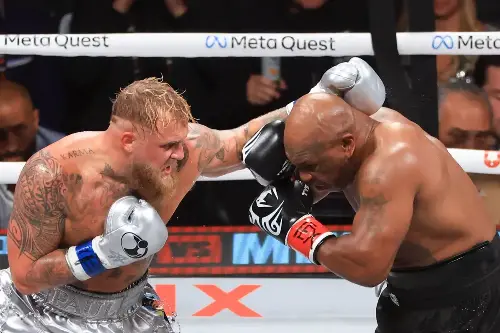
When the bods at the Disney channel, back in 2016, put together the cast list for Bizaardvark, they could’ve had little idea that, within a decade, two of their young stars would be selling out stadiums. Olivia Rodrigo, on the one hand, playing to 50,000 fans in Manila on the world tour for her new album – and clean-cut Jake Paul, on the other, punching a 58-year-old Mike Tyson, in the face, for 72,000 paying spectators in Texas. But then again, few people could have predicted the trajectory of modern superstardom.
Jake Paul vs Mike Tyson was but the latest in a series of fights intended to repackage sports for a generation addicted to the creator economy. The choice of Tyson, as an opponent, has been controversial: he’s old, has had health issues, and has struggled with drug and alcohol addiction. Ah well, let’s see how he does in the ring with a jacked 27-year-old from Cleveland, and, for good measure, let’s broadcast the whole thing on Netflix, as the platform’s first serious foray into live sports.
In the end, the night was a story of the buff and the buffering. This is not Netflix’s first attempt at live broadcasting. Last year, for example, comedian Chris Rock premiered a comedy special, Selective Outrage, on the platform. The demand for that was likely to be far lower than Paul vs Tyson, and Netflix’s overburdened servers quickly started to groan. In the hours of coverage preceding the headline fight, service was interrupted every few minutes (later, Paul would narrativise this as: “over 120 million viewers on Netflix – we crashed the site!”). At one point the entire system automatically rebooted itself. Executives at Sky or TNT must’ve been licking their lips. “See? This isn’t as easy as you thought…”
And yet eventually the kinks largely resolved themselves. The team in Arlington’s AT&T Stadium were led by Kate Scott (whose odds of being the next Match of the Day presenter must drift with every spectacularly lucrative gig she books), who was debuting a new transatlantic accent. She was joined by boxer Andre Ward, and the commentary team was led by veteran announcer Mauro Ranallo. It was all very credible, and yet the stream kept freezing, and the boxing, when it arrived, was equally stuttering.
To add cachet to this circus, a serious fight was arranged as a co-feature: an eagerly anticipated rematch between Irish boxer Katie Taylor and her Puerto Rican rival, Amanda Serrano. It was a brutal encounter, and Taylor’s victory a highly controversial one. The crowd were, briefly, euphoric – a reminder of the true potency of high calibre athleticism. “Who knew two women could co-headline a fight like this,” an emotional Serrano told viewers. “I’m on Netflix!”
As the streamer’s dogsbodies mopped lashings of blood off the canvas, the mood in Texas became strange. Amped up by a feeling of injustice perpetrated against Serrano, a febrile note entered the air. Despite the event being concocted by Paul’s Most Valuable Promotions company, the crowd seemed heavily in favour of the ageing slugger. Cameras cut to superstars of American sports like Shaquille O’Neal (“I hope Tyson whoops his ass”) and Rob Gronkowski. Paul, Paul, Paul, the branding said; Mike, Mike, Mike, the crowd chanted in reply.
The contrast between the two fights was stark, like a double bill of Rashomon and Digimon. Jake Paul, Netflix and the media at large have colluded in a narrative that “Iron” Mike is back, that the “beast” has been unlocked. But it became rapidly clear that the motivation for the fight was financial, not athletic. Tyson came into the ring, threw a few punches and tried to stay on his feet. Paul jockeyed around him, prolonging the feeble bout like a man whose business interests were better served by it going the distance. After all, Netflix is not a Pay Per View broadcaster like Sky. PPVs are incentivised to have a dramatic fight, however brief. Netflix, on the other hand, is obsessed with the “watchtime” metric, and boy did they string this evening out.
The box office result would have been a Tyson win, against the odds. The worst, but more realistic, scenario was witnessing Paul knocking the legend out cold. Both would have been problematic results, but good television. In the end, the fight was a pitiable encounter. Tyson seemed uninterested and incapable of competing, and Paul appeared conscious that beating the s*** out of a 58-year-old man isn’t a great look. In the final seconds of the fight, the younger man dropped his gloves and bowed to his opponent, a late show of respect. The capacity crowd at the AT&T Stadium let out an audible sigh.
The premise of Paul’s boxing career has been trying to convince – gaslight, is another word – people into believing this is a sporting endeavour. But even though Netflix invested in the infrastructure to broadcast the event to the highest specs of PPV boxing presentation, the product was still uncanny. Great presenters, great analysts, great commentators: all working in service of an almost indecent sporting proposal. “Hate him or love him, you’ve got to respect what Jake Paul has contributed to the sport of boxing,” said actor Rosie Perez who, for some reason, was calling the fight.
But do we have to respect him? This fight, conducted between a convicted rapist – or “the baddest man on this planet”, as the MC purred – and a dead-eyed, Trump supporting YouTuber felt like bad sport and indifferent entertainment. Huge money has been pumped into celebrity boxing in recent years, but the spectacle hasn’t improved. Paul vs Tyson was just the latest ignominious chapter in this dismal trend. If Netflix aspires to become a genuinely competitive sports broadcaster, this evening they took a technical, and creative, battering.
© Independent Digital News & Media Ltd
